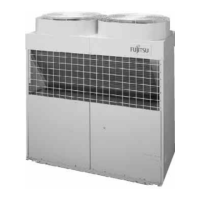Why is composition control necessary for charging refrigerant R407C in a Fujitsu Air Conditioner?
- CChristine SmithAug 3, 2025
Composition control must be maintained for charging refrigerant because R407C is a zeotropic refrigerant.

Why is composition control necessary for charging refrigerant R407C in a Fujitsu Air Conditioner?
Composition control must be maintained for charging refrigerant because R407C is a zeotropic refrigerant.
Why is review of control system required with R407C in Fujitsu Air Conditioner?
A review of the control system is required because there is temperature glide with R407C.
How to handle refrigerant R22 in a Fujitsu AB12 Air Conditioner to avoid oxygen starvation?
Handling refrigerant R22 may cause oxygen starvation in an airtight room because the specific gravity of R22 vapor is larger than that of air. Be sure to handle it only in a well-ventilated area.
| Power Supply | 220-240V, 50Hz |
|---|---|
| Refrigerant | R410A |
| Cooling Capacity | 12000 BTU |
| Heating Capacity | 13000 BTU |
| Outdoor Unit Dimensions (WxHxD) | 780x540x285 mm |
Details the construction of outdoor and indoor units, including types and capacities.
Details conditions for system setup, including refrigerant piping and system wiring requirements.
Explains how to set addresses for units, remote controllers, and central remote controllers.
Lists essential checks to perform before initiating a test run for the air conditioning system.
Outlines procedures for test operation using wired and wireless remote controllers.
Describes system operation during test runs and its initialization settings.
Illustrates the refrigerant pipe system configuration for cooling and heat pump models.
Depicts the refrigerant pipe system configuration for heat recovery models.
Shows the physical layout and component connections of indoor and outdoor unit PCBs.
Illustrates the block diagram of the microprocessor for indoor and outdoor units.
Lists the functions associated with each microprocessor connection and switch.
Details the functions and settings of various DIP switches for indoor units.
Explains compressor operation conditions, stop conditions, output patterns, and recovery.
Explains heat exchanger capacity control based on valve and expansion valve states.
Covers the ON/OFF and speed control of the outdoor fan motor.
Explains the four states of expansion valve control: STOP, STAND BY, WATCHING, CONTROLLING.
Details the operation and switching of the four-way valve 1 based on operation modes.
Explains the control of circulating save amount related to expansion valve operation.
Describes the control of the electromagnetic valve 2 for circulating save amount.
Explains system type switching and operating mode settings for four-way valve 5.
Details the conditions for starting, restricting, and ending defrosting operations.
Explains oil return control using solenoid valves and oil sensors.
Describes the conditions and operation of oil recovery.
Covers discharge temperature, high-pressure, and heating overload protection functions.
Explains the conditions and flowchart for pump down control.
Explains timer modes (OFF, ON, WEEKLY) and setup procedures.
Covers fan control in AUTO, LOW, MED, and HIGH positions.
Explains operation modes and auto changeover for heat recovery types.
Provides instructions for adjusting vertical and horizontal air direction and swing.
Explains the automatic control process for electronic expansion valves.
Covers auto restart behavior after power interruption or restart.
Explains the operation of the drain pump based on refrigerant circulation and float switch.
Shows wiring diagrams for universal floor and ceiling indoor units.
Shows wiring diagrams for large ceiling indoor units.
Shows wiring diagrams for compact duct indoor units.
Shows wiring diagrams for low static pressure duct indoor units.
Shows wiring diagrams for high static pressure duct indoor units.
Shows wiring diagrams for compact cassette indoor units.
Shows wiring diagrams for new cassette indoor units.
Shows wiring diagrams for wall-mounted indoor units.
Shows the wiring diagram for the outdoor unit.
Troubleshooting for indoor units, including operation displays and error indicators.
Troubleshooting for outdoor units, covering normal and abnormal operation displays.
Lists error codes and their contents for the remote control unit.
Troubleshoots indoor unit errors based on error codes, causes, and remedies.
Troubleshoots outdoor unit errors based on error codes, causes, and remedies.
Troubleshoots issues with PC boards, memory, settings, and communication for central controllers.
Addresses common operational issues without specific error codes.
Discusses causes of abnormal indoor unit sounds, like valve or electronic expansion valve faults.
Covers causes of indoor unit water leaks, including drain hose and pump faults.
Addresses various troubleshooting topics including valve, sensor, and temperature issues.
Provides thermistor characteristics, pressure sensor details, and other component troubleshooting.
Shows states of valves and EEVs for heat exchanger capacity control in cooling and heating.
Defines CFC, HCFC, and HFC refrigerants and their properties.
Compares R22 and R407C characteristics, handling, and selection.
Discusses differences and precautions for oil, compressor, heat exchanger, and valves.
Lists necessary tools and equipment for handling R407C refrigerant.
Covers precautions for copper pipes, contaminants, refrigerant charge, and air purge.
Lists precautions for refrigerant leaks, piping, parts replacement, charging, and storage.
Lists parts and their numbers for outdoor units (AOY90TPAMF).